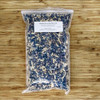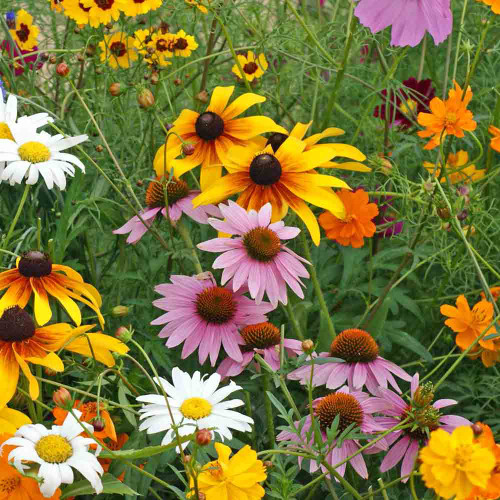Description
Garden Cover Up Seed Mix - The Natural Way to Transform Your Garden Soil
We believe a garden is more than just a place to grow plants; it's a living ecosystem. The most important, and often overlooked, part of that ecosystem is the soil. For a long time, the common approach has been to treat the soil like an empty container that we constantly have to fill with amendments. But what if we could shift our perspective and treat our soil like a living partner?
Instead of feeding our garden with a constant cycle of fertilizers and other inputs, we can help it build its own lasting fertility from the roots up. This is the philosophy behind our Garden Cover Up Mix. It's not just another amendment you add; it's a soil-building system you grow. By planting this carefully selected team of cover crops, you shift from a short-term mindset to a long-term strategy, creating a healthy, living soil ecosystem that will support your garden for seasons to come.
A System That Does the Work for You
This mix is a system designed with a purpose, a collaborative team of plants where each member performs a specific and complementary job to improve your soil's health and structure.
- The Nitrogen-Fixers (The Legumes): Crimson Clover, Field Peas, and Hairy Vetch act as the "fertilizer factories" of the mix. They pull nitrogen from the air and convert it into a form that your future vegetable crops can use.
- The Biomass-Builders (The Grains): Cereal Oats and Cereal Rye are the workhorses. They grow quickly to form a thick, protective mat that smothers weeds, prevents erosion, and adds a massive amount of valuable organic matter back into the soil.
- The Soil-Breaker (The Specialist): Buckwheat is the fast-acting specialist. It grows rapidly to shade out weeds, its flowers attract a host of beneficial insects, and its fine roots are experts at loosening compacted soil.
Together, this polyculture acts as a powerful "probiotic for your soil." The diverse root systems exude a complex mix of sugars and proteins that attract and feed the beneficial fungi and microorganisms that build healthy soil structure. This inoculates the garden with a diverse range of nutrients, creating the rich, fertile foundation that every successful garden needs.
A Tool for Every Season and Every Gardener
This mix is a versatile tool, designed to perform several crucial "jobs" in your garden throughout the year.
- The Weeder: This system's dense growth is an extremely effective way to suppress and outcompete even the most stubborn weeds, including bindweed, by shading them out and creating a physical barrier. Even better, its long-term action builds a fertile soil that naturally discourages weed seed germination in the following season.
- The Quick Recharge: Plant this mix for just 30 days in a bed that's in transition between your summer and fall crops to give the soil a quick, powerful boost of life and organic matter.
- The Expert-Level Prep: Because of their short root systems, garlic and onions require a loose, fertile soil to thrive. Planting this mix for a month before you plant your alliums is the perfect way to prepare an ideal bed for a bumper crop.
Guidance for Your Climate
- For Our Cool-Winter Gardeners: This mix is the perfect tool to plant in the fall. It will protect your soil from winter erosion and, as it decomposes, will enrich it for a strong start to your spring garden.
- For Our Warm-Winter Gardeners: Use this mix as a strategic tool during the transition out of summer. Plant it at least one month before the peak heat arrives, allowing it to grow and cover the soil. Then, cut it back to create a protective mulch that will decompose during the hot months. This prepares your soil perfectly for your fall "second spring" planting. It's also an excellent "recharge" crop to plant between your fall and true spring seasons.
What's in the Mix: A balanced blend of legumes (Crimson Clover, Field Pea, Hairy Vetch), grains (Cereal Oats, Cereal Rye), and the specialist (Buckwheat).
How to Plant and Use
Getting your Soil-Building System started is a simple process.
- Planting Rate: A little of this mix goes a long way. We recommend using 4 ounces of seed for approximately every 100-125 square feet of garden space (a 10x10 or 10x12 foot area). One pound of seed will generously cover a 400-500 square foot garden (a 20x20 or 20x25 foot area).
- Preparation: Simply prepare a clean seedbed by removing any existing weeds or crop residue and lightly raking the surface of the soil.
- Sowing: Broadcast the seed evenly across the prepared area. There's no need for perfect rows; the goal is to create a dense, living blanket. Gently rake the seed into the top quarter-inch of soil to ensure good seed-to-soil contact.
- Watering: Water the area regularly, keeping it consistently moist until the seeds have germinated and the young plants are established.
When to Terminate the Cover Crop
The timing for cutting down your cover crop depends on your goals. For a quick "recharge," you can cut it down any time after about 30 days of growth, which is typically enough time to develop an excellent network of roots and leafy biomass.
For maximum benefit, the ideal time to terminate the crop is after the first flowers have bloomed but before they set seed. This is a crucial step that prevents the cover crop from self-sowing and competing with your next season's vegetables. We've found it helpful to tie a small ribbon around the first flower you see, which acts as an easy-to-spot visual reminder.
To terminate the crop, simply cut the plants down at the soil level, leaving the residue on the surface as a nutrient-rich, weed-suppressing mulch. For larger areas, a mower or a string trimmer is effective. For raised beds or smaller gardens, garden shears or even a sharp hoe will work perfectly. In cool climates, a hard killing frost will also naturally terminate the crop for you.
If you don't use the entire mix in one season, there's no need to worry. The seeds will remain viable for next season; simply store the remainder in a cool, dry place.
Learn More
- Cover Crops - Better Soil in a Month
- Why Grow Cover Crops: Easy Soil Improvement
- Cover Crops Beat Garden Weeds
- Cover Crops FAQ
- Which Cover Crop is Best for Me?
From the soil to the seed to the food you eat - we'll help you grow your best garden!
5 Reviews
-
Cover cropping with Cover Up Seed Mix
I'm pretty darn impressed by the quick germination of the seeds in this packet. They practically leaped from the prepared beds, although our hot, humid weather might account for this. I only wish I had ordered more the first time. You probably will wish the same, so consider ordering an additional packet in case you run short.
-
Garden Cover Up Seed Mix
Germination was excellent. I have a beautiful cover crop that the bees are totally enjoying. This mix has been the easiest cover crop I have ever planted, no fuss, very little upkeep, just add a little moisture. Its so magnificent I spend 5-10 minutes every day just enjoying it.
-
Garden Cover Up Seed Mix cover crop
Germination rate was great! The variety of plants is interesting and I am hopeful that this "green manure" will amend my garden soil.
-
Big difference in yields
I've grown vegetables in my 4 4'x12' raised beds for over 25 year, renewing the soil annually with a layer of compost; yields had become just OK. Two autumns ago I planted the Cover Up Mix, turned it into the soil in spring, covered the beds with the usual compost; happily report last year's yields were up appreciably. The garden was positively lush (an unusual state in our high desert environment with 2017's prolonged high summer heat). So I planted your cover crop mix again last fall and am looking forward to this year's results. Definitely recommend!
-
My First Experiment...
First time I've used a cover crop; planted 6 weeks ago in 1/2 of my garden because the other half was still producing. Easy to plant, grew quickly with great coverage. The best part is that everywhere the cover crop was planted there are NO WEEDS! Morning glory has been my biggest problem and I have none where I planted the cover crop. Seeing the comparison between the two halves has made me a believer... already re-ordered enough for the whole garden for next year, and plan on using it in my flower beds, too. Highly recommend!



















